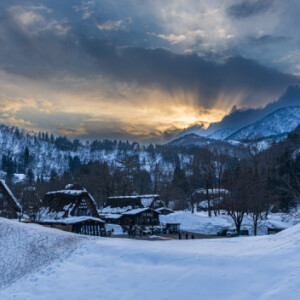Shirakawa-go
Our morning starts with a visit to the market, just over the road from our hotel. We’d visited yesterday, but I want to return with my 50mm lens and do a mono set similar to that in Hong Kong.
Japanese markets are a world away from Indian markets, for example - as you’d expect. Everything is wrapped - either for hygiene or for decoration. And, of course, the general colour from people’s clothing etc just isn’t there. But there’s a wealth of opportunity in the mystery of many foodstuffs, and as many stalls are basically little pop-up restaurants, there’s plenty of opportunity for people watching.
We have a bus to catch at 1.30 which will take us to our next destination, Takayama. It’s much more direct than going by train and as the route takes us through the mountains, it’s scenically excellent. Even better, it means we will have the chance to stop in Shirakawa-go. This is one of two World Heritage villages known for their idiosyncratic architecture of steeply sloped thatched roofs that reach almost to the ground - making it easier to encourage heavy falls of snow to slip from them and, apparently, allowing silk worm farming to continue through the harsh winters.
We’ve been travelling through snow for some time when we come to the village, steep walls of snow piles up at the sides of the roads. There have clearly been significant falls, but today is snow free and comparatively mild!
The scene is wonderfully picturesque - I’ll have to use that word again - magical! Some houses seem almost totally buried in the thick snow, only the roof apex sticking out. Others have areas cleared around them, but everywhere there are huge mounds of snow. All the houses seem to have ladders attached, and we can see why; whilst the roof shape man’s snow can slip down with comparative ease, thick snow seems to remain on the apex obviously putting a strain on the structure. We hear snow falling and trace the sound to a man shovelling the huge mounds on the top of his roof. Then we see his wife busily engaged with moving said snow from where it’s fallen. Of course snow also falls of its win accord, and there are several notices warning you of this danger from above!
And as we’re walking around the village there’s a surprise encounter with a great white egret, quite happy in the snow, and we’re also surprised to see there are plenty of fish in the little stream that’s flowing along the side of the road.
Shirakowa-go is, naturally - a real tourist honeypot, with coaches arriving from Karasawa, Takayama, and probably other places. When we arrive the place is extremely busy, though most have gone by the time we leave. Much is said about ‘over tourism’ - and certainly Japan’s a victim - and I feel distinctly uncomfortable about the way many wander off the pathways and roads, ignoring the fact that this is a place people actually live. It’s not a theme park.
We leave this enchanted world behind and continue to Takayama where we take the short walk to our accommodation for the next two nights - a stylish studio apartment. We’re too tired to venture far afield for food, but spot Jak’s Curry close by and get the last table in the tiny highly idiosyncratic restaurant. It’s a low table and we sit on the floor on cushions. With a fair bit of effort on both sides, we manage to order some sort of Japanese fried chicken curry for me and a pork curry for G. Both were delicious, accompanied by the heavy metal music preferred by Jak who was busy cooking behind the counter looking like a Japanese Jack Sparrow. An interesting end to another wonderful day.
https://www.japan.travel/en/world-heritage/the-historic-villages-of-shirakawa-go-and-gokayama/


Comments
Sign in or get an account to comment.


